+ Open data
Open data
- Basic information
Basic information
| Entry | Database: PDB / ID: 1dol | ||||||
|---|---|---|---|---|---|---|---|
| Title | MONOCYTE CHEMOATTRACTANT PROTEIN 1, I-FORM | ||||||
 Components Components | MONOCYTE CHEMOATTRACTANT PROTEIN 1 | ||||||
 Keywords Keywords | CHEMOATTRACTANT / CYTOKINE | ||||||
| Function / homology |  Function and homology information Function and homology informationhelper T cell extravasation / chemokine (C-C motif) ligand 2 signaling pathway / CCR2 chemokine receptor binding / negative regulation of natural killer cell chemotaxis / astrocyte cell migration / CCR chemokine receptor binding / positive regulation of apoptotic cell clearance / ATF4 activates genes in response to endoplasmic reticulum stress / negative regulation of glial cell apoptotic process / positive regulation of glutamate receptor signaling pathway ...helper T cell extravasation / chemokine (C-C motif) ligand 2 signaling pathway / CCR2 chemokine receptor binding / negative regulation of natural killer cell chemotaxis / astrocyte cell migration / CCR chemokine receptor binding / positive regulation of apoptotic cell clearance / ATF4 activates genes in response to endoplasmic reticulum stress / negative regulation of glial cell apoptotic process / positive regulation of glutamate receptor signaling pathway / NFE2L2 regulating inflammation associated genes / chemokine-mediated signaling pathway / eosinophil chemotaxis / cellular homeostasis / chemokine activity / Chemokine receptors bind chemokines / negative regulation of vascular endothelial cell proliferation / negative regulation of G1/S transition of mitotic cell cycle / positive regulation of macrophage chemotaxis / positive regulation of calcium ion import / chemoattractant activity / macrophage chemotaxis / Interleukin-10 signaling / monocyte chemotaxis / humoral immune response / positive regulation of endothelial cell apoptotic process / cellular response to interleukin-1 / G protein-coupled receptor signaling pathway, coupled to cyclic nucleotide second messenger / cell surface receptor signaling pathway via JAK-STAT / positive regulation of synaptic transmission, glutamatergic / cellular response to fibroblast growth factor stimulus / cytoskeleton organization / sensory perception of pain / viral genome replication / animal organ morphogenesis / response to bacterium / positive regulation of T cell activation / cellular response to type II interferon / cytokine-mediated signaling pathway / chemotaxis / antimicrobial humoral immune response mediated by antimicrobial peptide / cellular response to tumor necrosis factor / regulation of cell shape / cellular response to lipopolysaccharide / angiogenesis / Interleukin-4 and Interleukin-13 signaling / negative regulation of neuron apoptotic process / cell surface receptor signaling pathway / protein phosphorylation / protein kinase activity / cell adhesion / positive regulation of cell migration / G protein-coupled receptor signaling pathway / inflammatory response / signaling receptor binding / positive regulation of gene expression / signal transduction / extracellular space / extracellular region Similarity search - Function | ||||||
| Biological species |  Homo sapiens (human) Homo sapiens (human) | ||||||
| Method |  X-RAY DIFFRACTION / X-RAY DIFFRACTION /  MOLECULAR REPLACEMENT / Resolution: 2.4 Å MOLECULAR REPLACEMENT / Resolution: 2.4 Å | ||||||
 Authors Authors | Lubkowski, J. / Bujacz, G. / Boque, L. / Wlodawer, A. | ||||||
 Citation Citation |  Journal: Nat.Struct.Biol. / Year: 1997 Journal: Nat.Struct.Biol. / Year: 1997Title: The structure of MCP-1 in two crystal forms provides a rare example of variable quaternary interactions. Authors: Lubkowski, J. / Bujacz, G. / Boque, L. / Domaille, P.J. / Handel, T.M. / Wlodawer, A. #1:  Journal: Biochemistry / Year: 1996 Journal: Biochemistry / Year: 1996Title: Heteronuclear (1H, 13C, 15N) NMR Assignments and Solution Structure of the Monocyte Chemoattractant Protein-1 (Mcp-1) Dimer Authors: Handel, T.M. / Domaille, P.J. | ||||||
| History |
|
- Structure visualization
Structure visualization
| Structure viewer | Molecule:  Molmil Molmil Jmol/JSmol Jmol/JSmol |
|---|
- Downloads & links
Downloads & links
- Download
Download
| PDBx/mmCIF format |  1dol.cif.gz 1dol.cif.gz | 27.4 KB | Display |  PDBx/mmCIF format PDBx/mmCIF format |
|---|---|---|---|---|
| PDB format |  pdb1dol.ent.gz pdb1dol.ent.gz | 17.6 KB | Display |  PDB format PDB format |
| PDBx/mmJSON format |  1dol.json.gz 1dol.json.gz | Tree view |  PDBx/mmJSON format PDBx/mmJSON format | |
| Others |  Other downloads Other downloads |
-Validation report
| Summary document |  1dol_validation.pdf.gz 1dol_validation.pdf.gz | 360.7 KB | Display |  wwPDB validaton report wwPDB validaton report |
|---|---|---|---|---|
| Full document |  1dol_full_validation.pdf.gz 1dol_full_validation.pdf.gz | 363.4 KB | Display | |
| Data in XML |  1dol_validation.xml.gz 1dol_validation.xml.gz | 2.9 KB | Display | |
| Data in CIF |  1dol_validation.cif.gz 1dol_validation.cif.gz | 4.1 KB | Display | |
| Arichive directory |  https://data.pdbj.org/pub/pdb/validation_reports/do/1dol https://data.pdbj.org/pub/pdb/validation_reports/do/1dol ftp://data.pdbj.org/pub/pdb/validation_reports/do/1dol ftp://data.pdbj.org/pub/pdb/validation_reports/do/1dol | HTTPS FTP |
-Related structure data
| Related structure data |  1dokC  1domS S: Starting model for refinement C: citing same article ( |
|---|---|
| Similar structure data |
- Links
Links
- Assembly
Assembly
| Deposited unit | 
| ||||||||||||||||||
|---|---|---|---|---|---|---|---|---|---|---|---|---|---|---|---|---|---|---|---|
| 1 |
| ||||||||||||||||||
| 2 | 
| ||||||||||||||||||
| Unit cell |
| ||||||||||||||||||
| Components on special symmetry positions |
|
- Components
Components
| #1: Protein | Mass: 8830.239 Da / Num. of mol.: 1 / Mutation: INS(MET0) Source method: isolated from a genetically manipulated source Source: (gene. exp.)  Homo sapiens (human) / Plasmid: BL21 / Production host: Homo sapiens (human) / Plasmid: BL21 / Production host:  |
|---|---|
| #2: Water | ChemComp-HOH / |
| Has protein modification | Y |
| Sequence details | RESIDUE MET 0 IS AN ARTIFACT OF EXPRESSION |
-Experimental details
-Experiment
| Experiment | Method:  X-RAY DIFFRACTION / Number of used crystals: 1 X-RAY DIFFRACTION / Number of used crystals: 1 |
|---|
- Sample preparation
Sample preparation
| Crystal | Density Matthews: 2.8 Å3/Da / Density % sol: 56 % Description: INITIAL MODEL FOR MOLECULAR REPLACEMENT WAS MODIFIED AS DESCRIBED IN JOURNAL ARTICLE. | ||||||||||||||||||||
|---|---|---|---|---|---|---|---|---|---|---|---|---|---|---|---|---|---|---|---|---|---|
| Crystal grow | Method: vapor diffusion, hanging drop / pH: 8 Details: 10 MG/ML PROTEIN IN 50 MM TRIS BUFFER PH 7.5-8 EQUILIBRATED AGAINST 50-55% AMMONIUM SULFATE USING HANGING DROP VAPOR DIFFUSION METHOD., pH 8.0, vapor diffusion - hanging drop PH range: 7.5-8.0 | ||||||||||||||||||||
| Crystal grow | *PLUS Method: vapor diffusion | ||||||||||||||||||||
| Components of the solutions | *PLUS
|
-Data collection
| Diffraction | Mean temperature: 298 K |
|---|---|
| Diffraction source | Source:  ROTATING ANODE / Type: RIGAKU RUH2R / Wavelength: 1.5418 ROTATING ANODE / Type: RIGAKU RUH2R / Wavelength: 1.5418 |
| Detector | Type: MARRESEARCH / Detector: IMAGE PLATE / Date: Sep 11, 1995 / Details: COLLIMATOR |
| Radiation | Monochromator: GRAPHITE(002) / Monochromatic (M) / Laue (L): M / Scattering type: x-ray |
| Radiation wavelength | Wavelength: 1.5418 Å / Relative weight: 1 |
| Reflection | Resolution: 2.4→40 Å / Num. obs: 3573 / % possible obs: 87.9 % / Observed criterion σ(I): 0 / Redundancy: 2.41 % / Rsym value: 0.1 / Net I/σ(I): 8.1 |
| Reflection shell | Resolution: 2.4→2.49 Å / Redundancy: 2.2 % / Mean I/σ(I) obs: 2.62 / Rsym value: 0.267 / % possible all: 82.2 |
| Reflection | *PLUS Rmerge(I) obs: 0.1 |
| Reflection shell | *PLUS % possible obs: 82.2 % / Rmerge(I) obs: 0.267 |
- Processing
Processing
| Software |
| ||||||||||||||||||||||||||||||||||||||||||||||||||||||||||||||||||||||||||||||||
|---|---|---|---|---|---|---|---|---|---|---|---|---|---|---|---|---|---|---|---|---|---|---|---|---|---|---|---|---|---|---|---|---|---|---|---|---|---|---|---|---|---|---|---|---|---|---|---|---|---|---|---|---|---|---|---|---|---|---|---|---|---|---|---|---|---|---|---|---|---|---|---|---|---|---|---|---|---|---|---|---|---|
| Refinement | Method to determine structure:  MOLECULAR REPLACEMENT MOLECULAR REPLACEMENTStarting model: PDB ENTRY 1DOM Resolution: 2.4→10 Å / Rfactor Rfree error: 0.017 / Data cutoff high absF: 1000000 / Data cutoff low absF: 0.01 / σ(F): 2
| ||||||||||||||||||||||||||||||||||||||||||||||||||||||||||||||||||||||||||||||||
| Displacement parameters | Biso mean: 19.6 Å2 | ||||||||||||||||||||||||||||||||||||||||||||||||||||||||||||||||||||||||||||||||
| Refinement step | Cycle: LAST / Resolution: 2.4→10 Å
| ||||||||||||||||||||||||||||||||||||||||||||||||||||||||||||||||||||||||||||||||
| Refine LS restraints |
| ||||||||||||||||||||||||||||||||||||||||||||||||||||||||||||||||||||||||||||||||
| Xplor file |
| ||||||||||||||||||||||||||||||||||||||||||||||||||||||||||||||||||||||||||||||||
| Software | *PLUS Name:  X-PLOR / Classification: refinement X-PLOR / Classification: refinement | ||||||||||||||||||||||||||||||||||||||||||||||||||||||||||||||||||||||||||||||||
| Refinement | *PLUS | ||||||||||||||||||||||||||||||||||||||||||||||||||||||||||||||||||||||||||||||||
| Solvent computation | *PLUS | ||||||||||||||||||||||||||||||||||||||||||||||||||||||||||||||||||||||||||||||||
| Displacement parameters | *PLUS | ||||||||||||||||||||||||||||||||||||||||||||||||||||||||||||||||||||||||||||||||
| Refine LS restraints | *PLUS
|
 Movie
Movie Controller
Controller



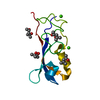
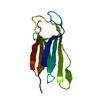
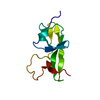

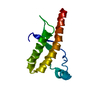

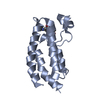



 PDBj
PDBj



